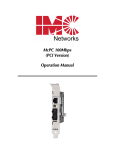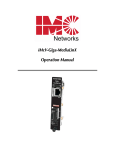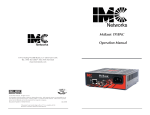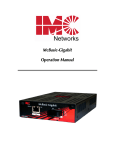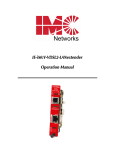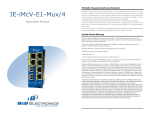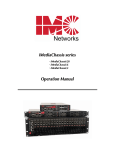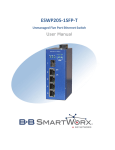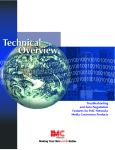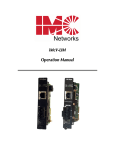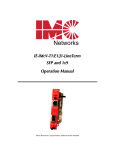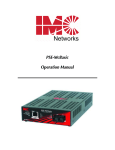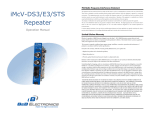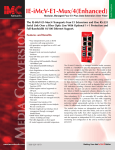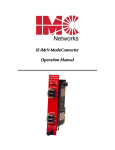Download Troubleshooting Features for Media Conversion
Transcript
WHITE PAPER : TROUBLESHOOTING FEATURES for Media Conversion Products Table of Contents Introduction.......................................................................................................... 3 Link Integrity ........................................................................................................ 4 Ethernet Troubleshooting Features .................................................................... 4 1. Auto Negotiation (AN) ........................................................................................ 4 a. Full Duplex ................................................................................................. 4 b. 100 Mbps Speed ...................................................................................... 4 c. Selective Advertising.................................................................................... 5 d. Rate Converters ........................................................................................ 5 e. FX Auto Negotiation (FX AN) ...................................................................... 5 2. FX LinkLoss (FXLL) ............................................................................................ 6 3. TX LinkLoss (TXLL) ............................................................................................ 6 4. FiberAlert (FA) .................................................................................................... 7 5. LinkLoss & FiberAlert ......................................................................................... 7 6. Link Fault Pass-Through (LFPT) ......................................................................... 8 7. Far End Fault (FEF) ............................................................................................ 8 8. 25 MHz “Keep Alive” Signal ............................................................................... 9 9. Flow Control (PAUSE) ........................................................................................ 9 Telco Troubleshooting Features ........................................................................ 1. LINK Quality .................................................................................................... 2. Remote Alarm Indication (RAI) ......................................................................... 3. Error (ER) ......................................................................................................... 4. Loss of Signal (LOS) ........................................................................................ 5. Alarm Indication Signal (AIS) ............................................................................ About B+B SmartWorx ................................................................................ 2 10 10 10 10 10 11 11 Introduction In keeping with B+B Network’s strategy of supporting its customers and their ability to configure and deploy products, this technical overview was developed to detail the product lines that offer a variety of diagnostic and troubleshooting features. The purpose of this technical overview is to define the features available and their functionality. With over one million products installed globally, B+B SmartWorx’ products are deployed where copper to copper, copper to fiber, dual to single-strand fiber or multi-mode to single-mode fiber conversions are required, carrying both managed and unmanaged media converter modules that support 10, 100, 10/100, 10/100/1000 and Gigabit Ethernet (up to 10G), T1/E1/J1, DS3/E3, VDSL, and SFP/SFP+/XFP technologies. B+B SmartWorx media conversion products with diagnostic features fall into two categories: Ethernet and Telco. Ethernet Troubleshooting Features • Auto Negotiation (AN) • Selective Advertising • FX LinkLoss (FXLL) • TX LinkLoss (TXLL) • FiberAlert (FA) • LinkLoss & FiberAlert • Link Fault Pass-Through (LFPT) • Far End Fault (FEF) • 25 MHz “Keep Alive” Signal • Flow Control (PAUSE) Telco Troubleshooting Features • LINK Quality • Remote Alarm Indicator (RAI) • Error (ER) • Bit Error Rate (BER) • Loss of Signal (LOS) • Alarm Indication Signal (AIS) Additional Features Information • Web page www.imcnetworks.com/products/ • Product Installation Guide • B+B SmartWorx | B+B SmartWorx Technical Support: Telephone: 800-346-3119 or [email protected] www.imcnetworks.com 3 Link Integrity When Link Integrity is lost, typically 90% of the causes can be attributed to one of the following three: • Mis-configuration of speed/duplex • Mis-matched fiber types • Hardware failure While a mis-configuration or a hardware failure is responsible for a large percentage of all LAN problems, physical cables, whether copper or fiber, can be prone to problems that are difficult to isolate, diagnose and resolve. These difficulties often result in LAN/WAN faults and expensive down time. For quick fault isolation and resolution, B+B SmartWorx offers various troubleshooting features in its products. By enabling the features, troubleshooting the faults allows the end user to identify and isolate the potential causes. The diagnostic and troubleshooting features are available and configurable in B+B SmartWorx managed and unmanaged products. Both product types configure the features via DIP Switch settings, while the managed products have the additional capability to be configured via software. Ethernet Troubleshooting Features 1. Auto Negotiation (AN) Auto Negotiation is an Ethernet standard that makes it possible for devices to exchange information about their speed and duplex capabilities over a link segment. This allows the devices to perform automatic configuration to achieve the best possible mode of operation over a link. Auto Negotiation can also provide automatic speed and duplex matching for multi-speed devices at each end of a link. Multi-speed Ethernet interfaces can then take advantage of the highest speed offered by a multi-speed device that matches the speed of the other device on the line. The following describes Auto Negotiation’s implementation in B+B SmartWorx products, based on the IEEE 802.3 standard. a. Full Duplex If a Full-Duplex device that supports Auto Negotiation receives Half-Duplex link pulses from a link partner, the Full-Duplex device places itself in Half-Duplex mode. Similarly, a Full-Duplex device will remain in that mode if it receives Full-Duplex link pulses. In the event an Auto Negotiation device receiving is not connected to another AN device, it will default to Half-Duplex mode. b. 100 Mbps & 1000 Mbps Speeds B+B SmartWorx 100 Mbps speed media converters auto negotiate for duplex mode ONLY. When Auto Negotiation is enabled, the B+B SmartWorx 100 Mbps converter negotiates as a 100 Mbps Full-Duplex device; if the link partner the converter is connected to can operate at 100 Mbps Full-Duplex, a link will be established. If the twisted pair port on the other link partner does not have the ability to auto negotiate, or if a 100 Mbps Full- or Half-Duplex connection is desired, Auto Negotiation on the converter must be disabled and set to a FORCE mode to the desired speed. Half- and Full-Duplex settings must be manually set and match on both end devices to which the converter is connected. Data errors will occur if the end devices do not share the same duplex mode. The same applies to 1000Mbps media converters. The speed is a straight speed and the auto negotiation is for the duplex mode on the copper segment only; fiber inherently is full duplex. 4 c. Selective Advertising Selective Advertising is available on some media converters. Refer to the product User Manual to determine if a media converter offers it or not. Selective Advertising, when used in combination with Auto Negotiation, advertises only the configured speed and duplex mode for the DATA port. If Auto Negotiation and Selective Advertising are both set to ON via DIP Switches, the DATA port’s speed (on a 10/100 Mbps media converter) and duplex mode (FDX and HDX) are configured to advertise only the speed you want to auto negotiate, instead of advertising all speeds and duplex capabilities. If you require a specific speed and/or duplex mode, B+B SmartWorx recommends using Selective Advertising rather than a Force Mode when connecting the modules to devices that can ONLY Auto Negotiate. Selective Advertising in not an option to set if you disable Auto Negotiation. d. Rate Converters B+B SmartWorx’ rate-converting 10/100 Mbps and 10/100/1000 Mbps media converters auto negotiate for BOTH speed and duplex mode, and feature several possible modes of operation (depending on the maximum speed offered): Auto Negotiation (AN), Force-10, Force-100, Force-1000. When using two 10/100 converters on either side of a media conversion, both converters should be configured for the same mode (refer to the user manual for settings). • Twisted Pair Auto Negotiation is the mode most ideally suited for 10/100 or 10/100/1000 media converters. In this mode, the converter will optimally and automatically configure for speed (10, 100 or 1000 Mbps) as well as duplex (Full or Half) depending on the capabilities of the end stations. • In Force-10 mode, the 10/100 or 10/100/1000 converter permits the transmission of valid 10 Mbps traffic only. In this mode, the media converter acts as a 10BASE-T/10BASE-FL media converter, rejecting 100 or 1000 Mbps signals. There is no Auto Negotiation in Force-10 mode. • In Force-100 mode, the media converter configures specifically as a 100BASE-TX/100BASE-FX/SX multimode or a 100BASE-TX/100BASE-FX single-mode fiber media converter. Note that Force-100 implies the rejection of 10 Mbps signals. There is no Auto Negotiation in Force-100 mode. • In Force-1000 mode, the media converter configures specifically as a 1000BASE-TX/1000BASEFX/SX multi-mode or a 100BASE-TX/100BASE-FX single-mode fiber media converter. Note that Force-1000 implies the rejection of 10 or 100 Mbps signals. There is no Auto Negotiation in Force-1000 mode. NOTE: Force modes should only be used when the devices connected to the media converter do NOT support Auto Negotiation. B+B SmartWorx media converters typically cannot be manually set for Half- or Full- Duplex. While the media converters are capable of FDX and HDX, they rely on the link partner’s configuration at each end to determine the duplex mode. Media converters are transparent devices. e. Fiber Auto Negotiation (FX AN) The 1000BASE-X fiber optic media system has an Auto-Negotiation specification that allows the link partners on a Gigabit Fiber optic link to determine which modes of operation they support in common (Force Full or Half-duplex or AN) and then link accordingly. The 1000BASE-X Auto Negotiation standard is defined in Clause 37 of the IEEE 802.3 standard. Based on this standard, B+B SmartWorx has incorporated this standard into all of its media converters capable of Gigabit speed over fiber. www.imcnetworks.com 5 2. Fiber LinkLoss (FXLL) FX LinkLoss (Fiber LinkLoss) is a troubleshooting feature. When a fault occurs on the fiber segment of a conversion, FX LinkLoss detects the fault and passes this information to the twisted pair segment. If a media converter is not receiving a fiber link, FX LinkLoss disables the transmitter on the media converter’s twisted pair port. This results in a loss of link on the remote twisted pair device. Diagram 1. FXLL - Disabled & Enabled 3. Twisted Pair LinkLoss (TXLL) TX LinkLoss (Twisted Pair LinkLoss) is a troubleshooting feature. When a fault occurs on the twisted pair segment of a conversion, TX LinkLoss detects the fault and passes this information to the fiber segment. If a media converter is not receiving a twisted pair link, TX LinkLoss disables the transmitter on the media converter’s fiber port. This results in a loss of link on the remote fiber device. Diagram 2. TXLL - Disabled & Enabled 6 4. FiberAlert (FA) FiberAlert minimizes the problems associated with the loss of one strand of fiber. If a strand is unavailable and FiberAlert is enabled, the B+B SmartWorx device at the receiver end notes the loss of the link. The device will stop transmitting data and the link signal until a signal or link pulse is received. The result is that the link LED on BOTH sides of the fiber connection will extinguish, indicating a fault somewhere in the fiber loop. Using FiberAlert, a local site administrator is notified of a fault and can quickly determine where a cable fault resides. FiberAlert can only be enabled at one end of the fiber line and should only be used on 100 Mbps fiber lines where the far end unit does not support Far End Fault (FEF). The Far End Fault function should always be used in place of FA if it is supported. Diagram 3. FiberAlert - Disabled & Enabled 5. LinkLoss & FiberAlert If the product does not have LFPT available, the recommended configuration is the use of LinkLoss and FiberAlert. In a typical central office to remote location media conversion, B+B SmartWorx recommends the configuration of the media converters’ troubleshooting features as indicated in the following table. FiberAlert/LinkLoss Comparison Table Feature Enabled Fault Location Disabled LEDs FiberAlert Remote Site Only Fiber Fiber TP/TX LinkLoss Remote Site Twisted Fiber FO/FX LinkLoss Main Site (or both) Fiber Twisted Diagram 4. - LinkLoss & FiberAlert www.imcnetworks.com 7 6. Link Fault Pass-Through (LFPT) LFPT is a troubleshooting feature that combines TX LinkLoss and FX LinkLoss from both the local and remote B+B devices. This feature, when enabled, will pass a link fault through the device at each segment. If a link fails on one side of the media converter, the media converter will force the link down on its link partner. When enabled, the TXLL and FXLL LEDs glow GREEN; when a fault occurs on a particular segment, the TXLL and FXLL LEDs will will blink or extinguish, depending on the product’s capability. Diagram 5. - Link Fault Pass Through 7. Far End Fault (FEF) When enabled, this feature is triggered as a fault occurs on the fiber line, affecting data in one direction, causing a FEF signal to be sent in the opposite direction, indicating the fault. Diagram 6. - Far End Fault 8 8. 25 MHz “Keep Alive” Signal On the IE-iMcV-ModeConverter, when the Link Loss (LL) feature is not enabled and the unit detects a loss of an incoming signal, it sends a 25 MHz “Keep Alive” Signal to the outgoing optical line. This feature only operates with Protocol Independent Mode Converters, as all Protocol dependent converters may falsely detect the 25 MHz signal as a loss of signal. If the LL feature is enabled and a loss of an incoming signal is detected, the optical transmitter on the other port is turned OFF. The LL feature is bi-directional and can be enabled from SFP1-to-SFP2, from SFP2-to-SFP1, or both at the same time. Diagram 7. - MHz “Kept Alive” Signal 9. Flow Control (PAUSE) Flow Control is the utilization of the Ethernet flow control mechanism, PAUSE. It is used as a form of back pressure on the receiving unit to avoid dropping Ethernet frames due to data congestion. To utilize Flow Control the link partner (connected device) must also support Flow Control. If the Ethernet line is attempting to send more data than the receiving unit can support, then the receiving unit may discard the data due to congestion. However, overflow activity will be less if Flow Control is enabled as Flow Control (PAUSE) limits the number of dropped Ethernet frames by reducing the congestion, minimizing the overflow of the data. With the IE-iMcVVDSL2-LANextender, when the Ethernet line is attempting to send more data than the VDSL2 line can support, the Overflow (OVF) LED will come ON, indicating Ethernet frames are being discarded. www.imcnetworks.com 9 Telco Troubleshooting Features 1. LINK Quality This feature detects and adjusts the IE-iMcV-VDSL2-LANextender line quality (throughput) to reach the best bandwidth performance for the physical line connected to the unit. The user can also define the minimum bandwidth level and monitor its status by setting an alarm condition that is reported to the chassis management card, causing a TRAP to be sent whenever the bandwidth of the IE-iMcV-VDSL2-LANextender link falls below this user set level. 2. Remote Alarm Indication (RAI) When enabled, the unit indicates that a fault condition exists on the unit located at the far end. With an IE-iMcV-VDSL2-LANextender product, this occurs when an alarm is set; including a loss of LINK, Far End Fault, or an excessive error rate on the Ethernet port. On an iMcV-DS3/E3-LineTerm or iMcV-T1/E1/ J1-LineTerm product, when an RAI signal is received on the fiber port, an Alarm Indication Signal (AIS) is transmitted on the COAX line. Diagram 8. - Remote Alarm Indication 3. Error (ER) On an IE-iMcV-VDSL2-LANextender, an error indicates a symbol error on either the VDSL or DATA Port, or when the VDSL bandwidth falls below the user defined-level. With an iMcV-DS3/E3-LinTerm or iMcVT1/E1/ J1-LineTerm product, an error is due to a line code violation received by the unit. 4. Loss of Signal (LOS) This condition occurs when the port does not receive a signal. In the case of an iMcV-DS3/E3-LineTerm or iMcV-T1/E1/J1-LineTerm product, an AIS signal is also sent. 10 5. Alarm Indication Signal (AIS) On an iMcV-DS3/E3-LineTerm, iMcV-T1/E1/J1-LineTerm or iMcV-E1Mux/4 product, an all 1’s AIS signal is sent whenever a Loss of Signal (LOS) is received on the fiber line. If Fault Loopback is enabled, AIS is also sent on the copper line when the RAI signal is received. Diagram 9. - Alarm Indication Signal About B+B SmartWorx Addressing legacy and cutting edge network topologies, B+B SmartWorx moves with today’s technology trends. IMC Networks, now under the umbrella of B+B SmartWorx, continues to offer FTTx and media conversion solutions for Enterprise, Government and Service Provider LANs, First-Mile FTTx Networks and Metropolitan Area Networks supporting numerous global customer applications such as delivering Internet services meeting SLAs, LAN extending using VDSL or fiber, or data over Ethernet. B+B SmartWorx provides complimentary, live technical support to assist network managers and system integrators with the design and development of their fiber-based networks: B+B technical support, online chat: www-bb-elec.com B+B technical support, email: [email protected] B+B technical support, phone: 1 (800) 346-3119 (Monday through Friday, 7:00am to 7:00pm CST) +353 91 792444 (Monday through Friday, 8:00am to 5:00pm GMT) B+B SmartWorx delivers excellence in product quality, customer satisfaction and value. Products are sold through a global network of authorized distributors, resellers and OEM partners in more than 60 countries. ISO 9001:2008 registered, all of B+B SmartWorx’ products are RoHS and REACH compliant, and carry a limited lifetime warranty. www.imcnetworks.com 11 Global Reach for Global Support You build your business and we will build your communication solution. Whether you choose standard products or require special designs for specific applications – consider B+B SmartWorx as your connection. WP44-#2115












